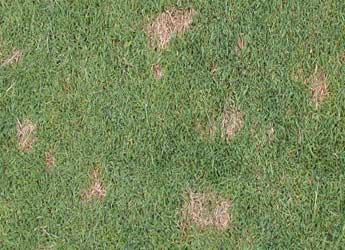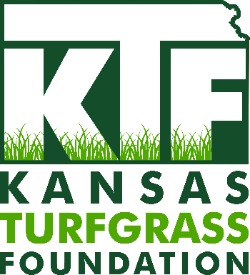Dollar Spot (Sclerotinia homoeocarpa)

Dollar Spot is caused by a fungal pathogen (Sclerotinia homoeocarpa) that blights leaf tissues but does not affect turfgrass roots or crowns. The disease is a common concern on golf course turf but outbreaks may occur in home lawn turf and can reduce aesthetic quality of the lawn and contribute to an overall decline in turf vigor. However, severe dollar spot in home lawn turf usually is a sign of neglect and poor turf maintenance.
In a Kentucky bluegrass or perennial ryegrass lawn, characteristic symptoms on individual plants include distinct lesions on leaf blades with straw-colored centers and red-brown margins. Characteristic symptoms of a more severe infestation include small (up to 1 inch in diameter) round, tan-colored spots, often occurring in clusters. When observed in the early morning hours, after a long dew period, the dollar spot pathogen will produce an abundance of mycelium on affected plant parts. The dollar spot pathogen survives in the turf environment as mycelium in infested turf debris.
Occurrence
The pathogen becomes active with rising temperatures in the spring. Mycelial growth and infection occur during extended (more than 8 hours) periods of dew over a broad range of temperatures (55° – 80°F). The severity of dollar spot development is increased significantly in turf stands that are deficient in nitrogen. The pathogen produces no spores; spread occurs through radial growth from individual infection centers and by the movement of infected and infested leaf blades, usually through turf maintenance operations such as mowing and core aeration.
Non-Chemical Control
Because dollar spot is most severe on nitrogen deficient turf, a balanced nitrogen fertility program will make significant contributions towards disease control. Adequate N nutrition will result in plants that are less prone to disease. The result will be a delay in disease outbreaks in the spring, reduced severity of outbreaks, improved fungicide performance, and more rapid turf recovery. Proper irrigation scheduling also may con tribute to dollar spot control. Since the duration of the dew period is proportional to the extent of infection, any irrigation practice that prolongs the dew period will contribute more to serious disease outbreaks. Night time and early morning irrigation is preferred. Irrigation in late afternoon and early evening hours should be avoided.
There are a number of biological control applications that are reported to contribute to reduced dollar spot severity. Some professional turf managers have had success with various biological control applications while others have experienced disappointment. Consequently, no specific recommendations can be made.
Chemical Control
Extensive dollar spot development in home lawns signals problems in general turf maintenance. The single most important maintenance factor that will influence the development of dollar spot and other diseases is nitrogen fertility. Lawns with serious dollar spot outbreaks are nitrogen deficient. The disease can be avoided by following a simple and balanced year-round program for nitrogen fertility. If unexpected outbreaks occur in summer months, disease will be suppressed with the application of approximately 0.5 lb actual N per 1000 sq ft per month. Regular mowing to a height of 2” - 3” will hasten turf recovery.
Fungicide application is rarely necessary for dollar spot control in home lawns. If a home owner thinks that control with fungcides is absolutely essential, then a professional custom applicator service should be hired for the application.



